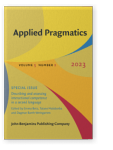Commentary
Nobody said it was going to be easy! (Practical) considerations in assessing interactional competence in the classroom
Article outline
- 1.Introduction
- 2.CA-SLA, IC, and applied CA and their implications for assessment
- 3.The testing principles
- 4.Conclusion
-
References
References (15)
References
Deppermann, A., & Pekarek Doehler, S. (2021). Longitudinal conversation analysis – Introduction to the special issue. Research on Language and Social Interaction,
54
(2), 127–141. 

Hall, J. K., Hellermann, J., & Pekarek-Doehler, S. (Eds.). (2011). L2 Interactional competence and development. Multilingual Matters. 

Huth, T. (2021). Conceptualizing interactional learning targets for the second language curriculum. In S. Kunitz, O. Sert, & N. Markee (Eds.), Emerging issues in classroom discourse and interaction: Theoretical and applied CA perspectives on pedagogy (pp. 359–382). Springer. 

Huth, T., & Taleghani-Nikazm, C. (2006). How can insights from conversation analysis be directly applied to teaching L2 pragmatics? Language Teaching Research,
10
(1), 53–79. 

Huth, T., Betz, E., & Taleghani-Nikazm, C. (2019). Rethinking language teacher training: Steps for making talk-in-interaction research accessible to practitioners. Classroom Discourse,
10
(1), 99–122. 

Kley, K. (2019). What counts as evidence for interactional competence? Developing rating criteria for a German classroom-based paired speaking test. In M. R. Salaberry & S. Kunitz (Eds.), Teaching and testing L2 interactional competence: Bridging theory and practice (pp. 291–321). Routledge. 

Markee, N., & Kasper, G. (2004). Classroom talks: An introduction. The Modern Language Journal,
88
(4), 491–500. 

Pekarek Doehler, S. (2021). Toward a coherent understanding of L2 interactional competence: Epistemologies of language learning and teaching. In S. Kunitz, O. Sert, & N. Markee (Eds.), Emerging issues in classroom discourse and interaction: Theoretical and applied CA perspectives on pedagogy (pp. 19–36). Springer. 

Pekarek Doehler, S., Wagner, J., & González-Martínez, E. (Eds.). (2018). Longitudinal studies on the organization of social interaction. Palgrave Macmillan. 

Sandlund, E., & Greer, T. (2020). How do raters understand rubrics for assessing L2 interactional engagement? A comparative study of CA- and non-CA-formulated performance descriptors. Papers in Language Testing and Assessment,
9
(1), 128–163.
Schegloff, E. A. (2007). Sequence organization in interaction: A primer in conversation analysis. Cambridge University Press. 

Walters, F. S. (2021). Some considerations regarding validation in CA-informed oral testing for the L2 classroom. In S. Kunitz, O. Sert, & N. Markee (Eds.), Emerging issues in classroom discourse and interaction: Theoretical and applied CA perspectives on pedagogy (pp. 383–406). Springer. 

Wei, L. (2018). Translanguaging as a practical theory of language. Applied Linguistics,
39
(1), 9–30. 

